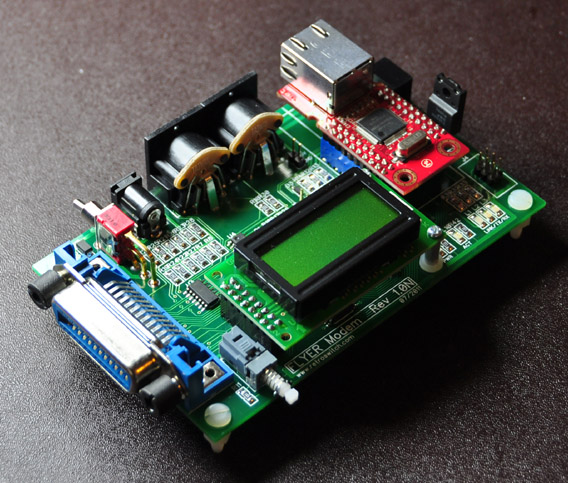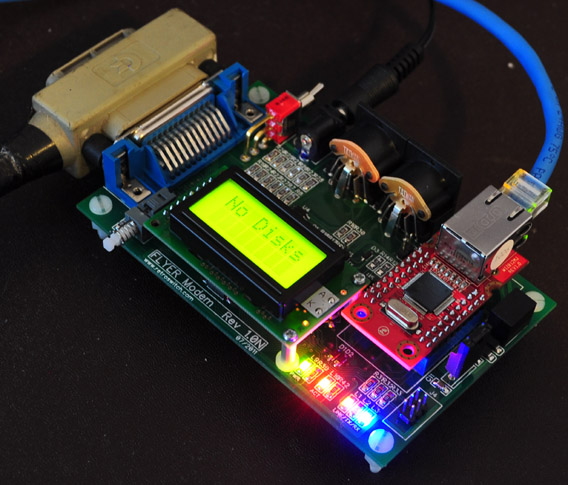I’m happy to report the prototypes work beautifully!

The first two prototypes were assembled a couple of days ago, but I decided to hold off posting photos until my backordered IEEE-488 connectors arrived (this morning – finally!).
A few minor tweaks will be made before ordering production boards (with red solder mask), including the addition of a trim pot for adjusting the display contrast and possibly switching to a vertically mounted IEEE-488 connector to keep a slimmer profile (and allowing the standard IEEE-488 cabling to run towards the back of the device instead of to the front – see next photo).

The bulk of my time will now be spent wrapping up the initial release firmware (can be updated via the internet), getting documentation put together, writing sample applications, etc. As promised, I will include some detailed information about both the hardware and software in an upcoming post.
I’m trying as hard as I can to make Flyer as powerful and easy to use as possible, and there’s already some pretty cool stuff I can’t wait to share!

Nicely done! Looking forward to seeing you demo it at the upcoming Commodore Computer Club meeting.
Hi, Wow you’ve made a lot of additions since I last saw this. Very impressive!
I like the addition of the IEEE-488.
I have some questions.
– What is the expected cost?
– Can IEC & IEEE-488 be used concurrently?
– WIll the device work OK on a VIC Switch?
– Can it be powered by 12VDC?
– How many R/W’s before the flash chip is worn out? I am a little concerned as it’s surface mounted to the PCB.
– Any chance of a future version having a SD or transflash card socket? This way if the flash memory is worn out you can easy replace the card.
– Can you work in the devices RAM only so as not to wear out the flash memory?
– Any Case planed?
– Any trendy logo sticker planed?
Thanks for making this, I have been wanting to get a IEC based network solution for my Commodores for years.
I refuse to put networking on the user port.
I’m glad you have made it an IEC device as it should be.
~Ken~
.-.-.
Hi Ken! Sorry for the delay in answering – we just moved and things are almost back to normal 🙂
To answer your questions:
– The price will probably wind up in the $125US range, due to some existing components increasing in price and the addition of some new components, such as the IEEE port and the LCD display.
– IEC and IEEE-488 can both be plugged in at the same time, and commands even alternated between the two (although I’m not sure how useful that would be 🙂
– I don’t know the specifics on the VIC switch as I don’t own one unfortunately.
– It is designed for 9VDC, although a 12VDC regulator would probably work OK. I will definitely test this when I get a chance.
– The flash memory is rated at 100,000 cycles, although they typically will endure much more. At any rate, I’m currently utilizing some techniques in code to balance wear, and this will improve as I make updates. The flash should last for many years of daily use.
– SD card support is definitely possible for a future version. I wanted to create a more network oriented device and had no intention of competing with the many SD card devices currently available. I consider the onboard flash memory more of a cache, rather than a dedicated storage device.
– The microcontroller only has 16KB of static RAM so there’s not much that can be done there (as far as offloading tasks that would naturally be done w/ the flash).
– I was toying around with a couple of case ideas, including a custom laser-cut clear acrylic design that would really look slick, esp. w/ the LEDs in action. Also, the LCD display is detachable and could be relocated/mounted in a custom enclosure if desired.
– Does italic count as a trendy logo? LOL
Thanks for the kind comments! I’m currently wrapping up the new bootloader for the Flyer and should be submitting final PCBs sometime next week if I’m lucky. Then it’s just a matter of bringing the initial feature set up to a release standard before announcing any kind of availability date.